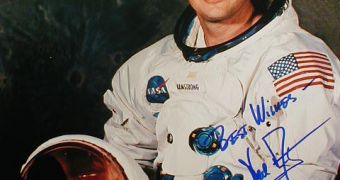Last Wednesday, the first American ever to have reached orbit, John Glenn, and the first man ever to have set foot on the Moon, Neil Armstrong, took the floor at the Smithsonian Air and Space Museum in Washington, DC., during the festivities that marked 50 years of activity for NASA. 78-year-old Armstrong saluted the efforts made by the American space agency over the years, and pressed for a more quickened pace in the conquest of space. He also pointed out that the space agency's mission was one of the utmost importance, as it led the way to a better understanding of the world we're all living in.
Speaking during one of his extremely rare public appearances, Armstrong reviewed the knowledge humankind gained since the beginning of the Space Age in the mid-'50s, such as the current understanding of how solar systems, galaxies, nebulas, clusters or black holes worked and, more importantly, why. He also underlined the importance of continuous space explorations, as well as that of exploring other planets firsthand.
During the same ceremony, John Glenn said that, given the 50 years during which man flew into space, Lunar and Martian landings should have been a regular occurrence by now. The same was pointed out by NASA's own chief, Mike Griffin, who complained about the sketchy support the space program had received over the past years, and expressed hope that, in the future, administrations in the White House would back up their verbal support more thoroughly.
All speakers voiced their concern about the questionable status of the U.S. presence on the International Space Station, a $100 billion international project meant to facilitate microbiological analysis, deep-space surveys, and material resistance tests, among other things. Given the fact that the space shuttle program is due to be closed down in 2010, Griffin said that the most optimistic prediction of a manned mission to Mars was still about 30 years away.

 14 DAY TRIAL //
14 DAY TRIAL //